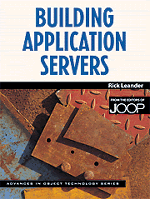Book contents
- Frontmatter
- Contents
- acknowledgements
- Introduction
- PART 1 ARCHITECTURE
- PART 2 DESIGN
- PART 3 PROGRAMMING
- Chapter 8 Implementing an Application Server Framework
- Chapter 9 Using Java to Build Business Objects
- Chapter 10 Persistent Objects: Communicating with Databases
- Chapter 11 Interfaces and Client-Side Communication
- Chapter 12 Enforcing Business Rules
- Chapter 13 Multiprocessing, Concurrency, and Transactions
- Chapter 14 The Next Generation of Business Applications
- Appendix: Setting up a Development Environment
- Index
Chapter 9 - Using Java to Build Business Objects
from PART 3 - PROGRAMMING
Published online by Cambridge University Press: 06 July 2010
- Frontmatter
- Contents
- acknowledgements
- Introduction
- PART 1 ARCHITECTURE
- PART 2 DESIGN
- PART 3 PROGRAMMING
- Chapter 8 Implementing an Application Server Framework
- Chapter 9 Using Java to Build Business Objects
- Chapter 10 Persistent Objects: Communicating with Databases
- Chapter 11 Interfaces and Client-Side Communication
- Chapter 12 Enforcing Business Rules
- Chapter 13 Multiprocessing, Concurrency, and Transactions
- Chapter 14 The Next Generation of Business Applications
- Appendix: Setting up a Development Environment
- Index
Summary
Creating business objects is a straightforward process in any object-oriented language. Just declare a class, list the attributes and methods, then fill in the business logic. This is basic object-oriented programming. The difficulty lies in linking these objects across a distributed network and getting them to perform useful work. This chapter will use the Java programming language to illustrate how business objects can be created and distributed across a network.
The Java programming language, released by Sun Microsystems in the mid-1990s, was originally intended to be used in consumer electronic devices such as personal digital assistants, cable access boxes, television sets, and other devices that required simple user interfaces. The language was designed to be hardware-independent by compiling to an artificial byte-code instruction set that could be easily implemented in an interpreter on almost any microprocessor device.
As the Internet and World Wide Web gained momentum, Web page authors wanted to add features like animation and interaction to their Websites. Since the Internet browsers had to run on a large variety of different computer platforms, the browser manufacturers found that the Java programming language, with its platform-neutral instruction set, was a good fit. The software could be compiled once, placed on a Web server, then run on any Java-enabled browser on a PC, Mac, UNIX, or other machine. Besides being platform-independent, the compiled files were small and moved quickly over the Internet.
- Type
- Chapter
- Information
- Building Application Servers , pp. 197 - 226Publisher: Cambridge University PressPrint publication year: 2000



